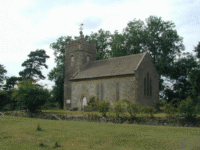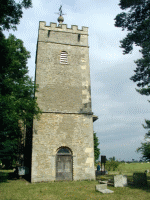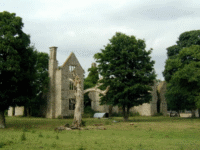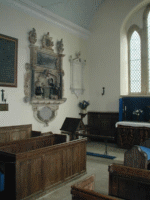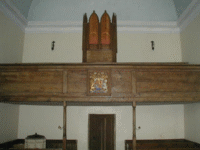HISTORY
The name "Gay" comes from
the de Gay family, who were the twelfth century Lords of the Manor.
THE LAND AND ESTATES
In 1086 there were two
estates; 3 hides belonging to Robert d'Ivry, and 2 hides (being a royal
demesne) held by Rainald, Robert d'Ivry's tenant.
The larger estate was
part of the honor of St Valery, and passed to Richard, Earl of Cornwall. In
1292, Edmund, the then Earl claimed his rights as overlord, and the
half-knight's fee became merged with the Duchy of Cornwall. The King's Estate
became part of the honor of Gloucester.
About 1137 Robert de Gay was
tenant of both the Hampton estates, and it was he who founded the monastery at
Otley. Between 1195 and 1205 Oseney Abbey in Oxford acquired 2 virgates of land
in Hampton from the de Guys, and in 1210 Robert de Gay started a series of
gifts to the Abbey, which by 1218 held nearly all the half-knight's fee of St
Valery. The Manor of Hampton was held by Oseney until the
Dissolution.
In 1542 the Crown sold the land to Leonard
Chamberlayne,
who fairly quickly re-sold it to John Barry of Eynsham for
£1,100.
In 1682 it was mortgaged and then sold to Sir Richard
Wenman of Caswell for £6,400.
The Manor and village has had a very
chequered history. In late Elizabethan times the inclosure of the lands around
Hampton Gay involved most of the male inhabitants of the village in an agrarian
revolt in 1596. This also involved people from as far away as Rycote and
Witney, but when the call to arms eventually was made only ten persons
assembled with pikes and swords on Enslow Hill,
Bletchingdon. Roger Symonds, a
carpenter from Hampton Gay, warned Vincent Barry, who in turn told Lord
Norrys.
Five Hampton Gay men were arrested and sent to London, and one was sentenced to
be hanged and quartered. Although abortive, it did in fact bring about the
re-enactment of the Tillage Acts in 1597, whereby lands in Oxfordshire which
had been converted to pasture since the accession of Queen Elizabeth, were
restored to tillage.
The Manor House was built by the Barry family in
the second half of the 16th century. It was destroyed by fire in 1887, when the
interior was gutted and the roof collapsed .
The Grist mill in the
parish, noted in the Domesday Book, was let by Vincent Barry in 1681 to John
Allen of Hampton as a paper mill. This greatly altered the pastoral economy of
the parish. The mill continued as a paper mill until 1887, although with a
break from 1865 to 1873 after a severe fire closed it temporarily. It was then
converted to a steam-powered mill with its own gas works, and was again
destroyed by fire in 1875. Its owners finally went bankrupt in 1887.
POPULATION
17th Century - 7 taxable houses for
Hearth Tax. (Manor House and two largish farmhouses or gent's houses [12
hearths], a small farmstead [3 hearths] and three cottages.
1676 - Compton
census - 28 adults
1811 - 13 houses
1821 - peaked to 86
inhabitants
1851 - 17 houses
1887 - fell to 30 inhabitants after
destruction of the Manor House
1901 - 6 houses
1955 - 14
parishioners
THE CHURCH
It is recorded that in 1074 there was a grant of Tythes,
and in 1173 Reginald de Gay presented his Clerk, Gilbert, to the Church with a
half-hide of land free of all service. He then granted the church to Oseney
Abbey.
In 1535 the Chancel and Nave had become dilapidated,
windows were broken, and no distribution to the poor was being made. £2
was being paid per annum to a Chaplain from Oseney Abbey.
After the Dissolution of the Abbey in 1539 Hampton Gay was
considered an extra-parochial free chapel, exempt from the Bishop's
jurisdiction. With no endowment, the Lords of the Manor "out of their
generosity" paid for a minister.
In 1768 the Church was rebuilt by Rev'd Thomas Hindes. He
also provided an endowment of £700 to be invested to provide £20
annually for a minister, preference being given to a Fellow from the Queen's
College, Oxford.
Eventually the Bishop began to licence Curates from 1809
onwards, and in 1854 the parish was transferred to the Bicester Deanery. In
1862 Wadham College purchased the Manor and provided a minister, who also
usually was the Rector of Shipton on Cherwell.
The Church of St Giles was built during the period 1767 to
1772, and was built on the foundations of the old church. The old church was
ruthlessly destroyed to make way for it, although a very few of the original
features were incorporated.
It is said to have been considered by admirers of the
Gothic architecture as "a very bad specimen of the meeting-house style"
[Parker: Church Guide, 1956].
In 1859 the then Curate had the church "restored" to his
own plans at a cost of £154. This entailed replacing the four
round-headed Georgian windows with "Early-English" style windows, and building
a new south porch (now gone). The tower door arch at its west end was notched
in Norman style, and the old seats were replaced. [See MS. Top. Oxon. b220. f.
156 - a drawing of the church in about 1800, and a further drawing (1822) by J
Buckler].
The remaining Georgian features are the Gallery, the coved
and panelled ceiling, the stone ball finial on the roof, and the weather
vane.
|

